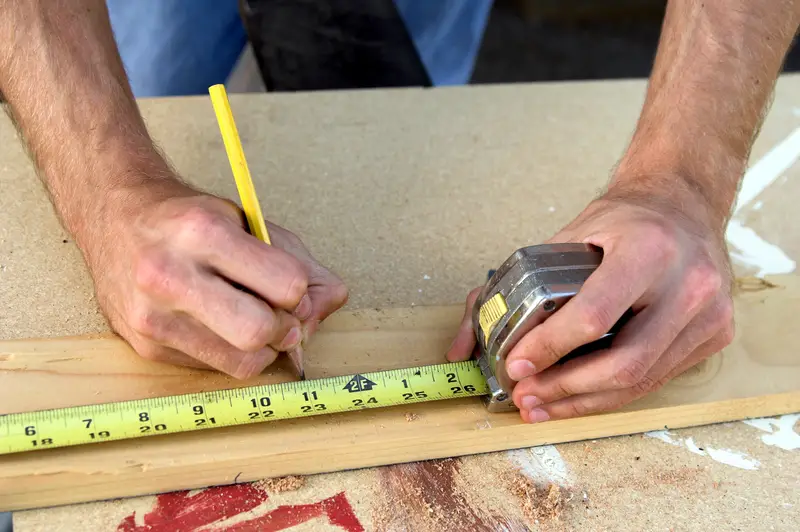Every homeowner has wrestled with a tape measure at some point, trying to get an accurate measurement while the metal tape flops around or snaps back unexpectedly. What most people don’t realize is that their tape measure has hidden features and techniques that professionals use daily to work faster and more accurately. That wiggly hook at the end isn’t broken, and those mysterious markings aren’t random decorations. These simple tricks can transform anyone from fumbling amateur to confident measurer in minutes.
The hook wiggle is actually a precision feature
Most people think their tape measure is defective when they notice the metal hook slides back and forth on its rivets. This movement seems like a manufacturing flaw, but it’s actually an engineered feature designed to ensure accurate measurements. The hook is intentionally loose to compensate for its own thickness, which is typically about 1/16 of an inch. When measuring from an outside edge by hooking onto it, the tab pulls outward to subtract its thickness from the measurement.
When pushing the hook against an inside surface, it moves inward to add that same thickness back to the measurement. This automatic adjustment means measurements stay accurate whether pulling or pushing. However, many people unknowingly press down on the hook while measuring, which throws off this calibration. Instead, hold the blade itself against the surface and let the hook do its job. If the hook gets bent or damaged, the entire tape measure becomes unreliable and should be replaced.
That hole in the hook creates perfect circles
The small hole or slot at the end of most tape measure hooks serves multiple purposes that go far beyond simple convenience. Its primary function is to grab onto screw heads or nail points, allowing solo measurements without needing someone to hold the other end. This feature proves invaluable when measuring long distances or working in tight spaces where positioning assistance isn’t available. The hole is precisely sized to fit standard screw heads and nail shanks securely.
The real magic happens when using this hole as a compass for drawing arcs and circles. Place a nail or screw at the center point of the desired circle, hook the tape measure to it, extend to the desired radius, and hold a pencil against the tape while rotating around the center point. This technique creates perfectly round circles without needing expensive compass tools. Contractors regularly use this method for marking curves on decking, creating rounded garden bed edges, or laying out circular patterns on floors.
Corner measurements require a different approach
Measuring inside corners presents one of the biggest challenges for amateur measurers. The natural instinct is to bend the tape measure blade around the corner, but this creates inaccuracies and can damage the metal tape over time. Bending puts stress on the blade that can cause kinks, affecting future measurements. The curved shape also means the tape doesn’t lie flat against both surfaces, creating gaps that throw off readings by several millimeters or more.
Professional contractors use a simple two-measurement technique instead. Measure from the corner to an easy number like 10 inches on one wall, mark that spot, then measure from the mark to the opposite wall and add 10 inches to get the total distance. Alternatively, many quality tape measures have their case width printed on the housing, usually around 3 inches. Push the entire case against one wall, read where the other wall hits the tape, and add the case width to get an accurate inside measurement without any bending or guessing.
Burning an inch gives more precise measurements
When the hook gets damaged or bent, or when measuring from an edge that won’t accommodate the hook properly, professionals use the “burn an inch” technique. Instead of starting at zero, begin the measurement at the 1-inch mark and subtract one inch from the final reading. This method eliminates any errors caused by a damaged or misaligned hook while providing extremely precise measurements. It works particularly well when measuring from rough or curved surfaces where the hook can’t sit properly.
This technique also proves useful when measuring small objects where the hook’s thickness becomes a significant percentage of the total measurement. For items under 6 inches, the hook’s movement can represent a meaningful error. Starting at the 1-inch mark and using a middle section of the tape ensures the most accurate reading possible. Remember to consistently subtract that inch from every measurement, or write a reminder note to avoid confusion. Many contractors prefer this method for finish work where precision matters most.
Mark your tape for repeated measurements
Rather than trying to remember common measurements or constantly referring to notes, smart builders mark their tape measure blade directly with measurements they’ll use repeatedly. A dry erase marker writes clearly on the metal surface and wipes off easily when the project ends. This creates a portable reference that’s always available without fumbling through pockets or losing scraps of paper with dimensions written on them.
Different colored markers can represent different measurements for complex projects with multiple components. Red might mark stud spacing, blue for trim pieces, and black for final cuts. This color-coding system prevents confusion and speeds up workflow significantly. Some professionals even use permanent markers for long-term projects, then remove the marks with acetone or rubbing alcohol when finished. This technique works especially well for repetitive tasks like installing flooring, hanging pictures, or building furniture with standardized dimensions.
Use the tape edge as a straight line guide
The curved design of tape measure blades serves a structural purpose, making them rigid enough to extend long distances without support. However, this curve can be used as a drawing guide for making straight lines when a proper straightedge isn’t available. Rather than trying to draw along the top of the curved blade, tilt the tape measure forward so only one edge contacts the surface. This creates a clean, straight line guide that’s often more convenient than searching for a separate ruler or straightedge.
Lock the tape at the desired length, hold it firmly with the non-writing hand, and trace along the bottom edge with a pencil. This technique works well for marking cut lines on lumber, drawing layout lines on walls, or creating reference marks on large surfaces. The key is maintaining steady pressure to keep the tape flat against the surface while drawing. For longer lines, extend the tape a few inches beyond the needed length to provide better control and prevent the tape from retracting mid-line.
Divide boards into equal sections easily
Dividing a board into equal sections becomes simple with an angled tape measure technique that eliminates complex fraction math. Instead of trying to divide an odd measurement like 14 11/16 inches into three equal parts, angle the tape measure across the board’s width until it reads a number easily divisible by the desired number of sections. For three sections, position the tape to read 15 inches, then mark at 5 and 10 inches to create three equal spaces.
This method works because the angled tape creates proportional spacing rather than actual measured distances. The marks will be evenly spaced across the board’s actual width, even though they don’t represent the true dimensions. For two sections, use any even number like 14 or 16 inches and mark at the halfway point. This technique proves invaluable for spacing fence pickets, dividing shelf space, or creating evenly spaced mounting points without complicated calculations or conversion charts.
Know your tape measure case dimensions
Most quality tape measures have their case dimensions printed somewhere on the housing, typically on the bottom or back. This measurement, usually around 3 inches, becomes crucial for accurate inside measurements where the tape can’t extend fully. When measuring window openings, door frames, or inside cabinet dimensions, push the entire case against one end and read where the opposite surface meets the tape, then add the case width for the total measurement.
This technique eliminates the guesswork and potential errors from trying to bend the tape or estimate angles. Professional contractors rely on this method daily because it provides consistent, accurate results without special tools or complicated procedures. If the case dimensions aren’t printed on the housing, measure it once and write the dimension on a piece of tape stuck to the case. Knowing this measurement by heart speeds up inside measurements and reduces the chance of costly mistakes from inaccurate dimensions.
Those mysterious markings actually serve specific purposes
The black diamonds or triangles that appear every 19.2 inches on many tape measures aren’t random decorations but specific spacing guides for engineered lumber construction. These marks help builders space engineered joists and trusses at optimal intervals for structural integrity while maximizing material efficiency. The 16-inch markings that are clearly highlighted serve the same purpose for standard stud spacing in residential construction, making it easy to mark consistent intervals without constant calculation.
Some tape measures also include marks for dividing 8-foot sheets into five equal sections, which helps with efficient material usage when cutting plywood or drywall. Understanding these markings can speed up framing work, help with material planning, and ensure proper structural spacing. Even for non-construction projects, these pre-marked intervals can serve as quick references for spacing shelves, hanging pictures, or planning garden layouts. Learning what each marking represents transforms the tape measure from a simple measuring tool into a comprehensive spacing guide.
These professional tape measure techniques can transform any home project from frustrating guesswork into precise, efficient work. The key is understanding that the tape measure contains more built-in features and capabilities than most people realize. Practice these methods on simple projects first, and soon they’ll become second nature for any measuring task around the house.

